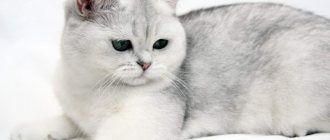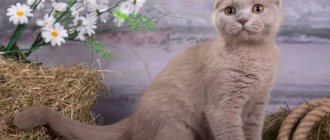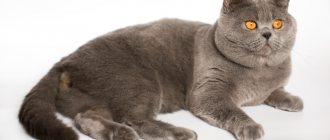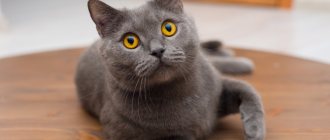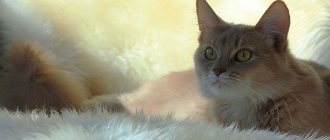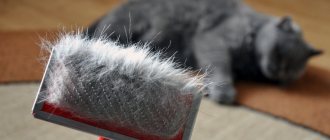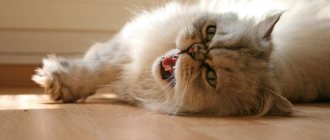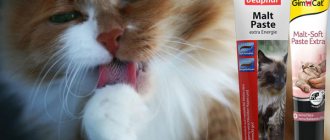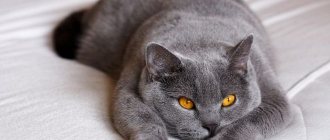Black cats with blue eyes look noble. Even no less noble than the snow-white beauties. Therefore, they are worth learning more about these coal-black beauties, including the difficult fate that befell them because of their black color.
Blue eye color has always attracted the attention of breeders. Well, as for black cats with blue eyes, they seem to be some kind of magical, mystical creatures, which aroused more and more interest among some people, and superstitious fear among others. However, if you yourself are not the source of harm to the cat, there is no reason to be afraid of it.
Heterochromia looks even more mysterious than just a combination of blue eyes and black color.
Black color in various combinations is present in almost all breeds. But before, and even now at times, absolutely black cats are unlucky, and they are accused of everything, trying to avoid them.
Still from the cartoon “The Scarecrow-Meow”.
Although for the Egyptians these animals were considered sacred, in the Middle Ages they were less fortunate - black cats were burned at the stake along with “sorcerers” and “witches”.
Many scientists are of the opinion that it was black cats that were the ancestors of today's pets. In addition, their black coloration gives them an advantage when hunting at night, which likely contributed to their high prevalence and survival rate.
Genetics of black color
Many Internet pages are full of photographs of black cats. What gives these animals such a beautiful color? The pigment eumelanin, which is responsible for the formation of black color, is responsible for this. This pigment is present in the cat’s hair in the form of granules, and the shade of the cat’s color depends on what shape they are, how much they are contained and where they are located. For example, the rich black color of the coat is given by the B (Black) gene in a dominant state. In this case, the eumelanin granules have a slightly elongated shape at the poles and are placed very tightly. In other, recessive conditions, the gene contributes to the appearance of calmer shades. Thus, species b pulls out pigment granules and separates them over long distances, resulting in a chocolate color. And the bl form further expands and moves the granules away from each other, resulting in a cinnamon color.
In most cases, black cats give birth to black kittens.
Perfect black cats are rare. At least minimally lightened areas are still present on the body, but they are often very well hidden and not noticeable.
Black cats are not a separate class. This color can be found in any breed. But blue eyes among them are a very rare phenomenon. Here are some of the cases where black cats have been observed to have blue eyes:
Bombay
Kittens are usually born with blue eyes, but as they age the color changes to yellow.
Oriental
Black Orientals even have jet black noses and toes.
Canadian Sphynx
Canadian Sphynx cats have unusually short mustaches.
Khao Mani breed: distinctive features
The snow-white cat from Thailand, called Khao Mani, or diamond eye, has a very ancient pedigree. It is easier to care for such a cat than a Persian, because it is a short-haired breed. This species got its name because of the special cut of the eyes - they are brightly outlined and shine like diamonds.
It is better not to get this cat for those people who are rarely at home, because she does not like loneliness and does not tolerate it well. In character, cats of this species are closest to Siamese.
Are blue eyes in cats rare or an exception?
Blue eyes are very rare in black cats.
In fact, blue eye color is quite common, especially in light-colored cats. Kittens are born with blue eyes, but this color may change with age. It all depends on the pigmentation, but there are completely inexplicable exceptions. In general, cats with black fur and blue eyes are very rare.
Blue-eyed black cats - Ojos Azules
Ojos Azules are one of the most mysterious breeds.
Ojos Azules is the only breed that combines black coat color and blue eyes, not as a huge exception. At first these cats had a tortoiseshell color, but after numerous crossings individuals with black fur were obtained.
Temperament and behavior
Their color can be varied, but the color of their eyes is always blue.
These cats are very calm and attached to their owner. They love attention, but will not attract it too intrusively and distract others from their work. Okhs cannot spend time without the company of their owner for a long time, but they are not entirely sociable with other pets. They love to play and when interacting with children they are not dangerous to them (of course, until they consider the children themselves dangerous to themselves - in this case, they will undoubtedly defend themselves without regard to the age of the person in front of them).
Features of care
Thanks to its silky texture, the cat's fur rarely gets tangled.
It is enough to brush cats of this breed several times a month, because although they can have both long and short hair, at the same time they have a sparse undercoat. In addition, it is important to trim the claws on time, firstly, so that the cat does not hurt itself, and secondly, so that it does not start sharpening them on everything it sees if there is no scratching post.
Health
Okhs have good health.
The most important feature of the breed, which should not be forgotten, is that representatives of this breed cannot be crossed with each other, as well as with other breeds if they have blue eyes - there is a high risk of sick, inferior or even dead offspring. In other cases, there is no need to worry, since representatives of the Ojos Azules breed have good immunity and good health. At the moment, no diseases characteristic of her have been identified. With proper nutrition and care, they can live up to seventeen years, and in some cases longer.
LiveInternetLiveInternet
Monday, June 25, 2012 17:01 + to quote book Elena_Mishakova
all posts by the author This is not a negative or a photomontage. The photo shows another little hope for many people for recovery or relief from the consequences of injuries and spinal cord paralysis. The researchers deliberately inflicted spinal injuries on the rats, and then injected them with a substance related to the food coloring “Blue Number One,” which is absolutely harmless. Their skin acquired a blue tint, but within a week, almost all the motor functions of the animals were restored, because the substance prevented inflammation of the spinal cord. No negative effects of the drug on the body of rats were detected.
Blue dart frog The blue dart frog is one of the most amazing colored animals on the planet. People use the poison from the skin secretions of this frog as an ingredient in painkillers. Local peoples use the venom of this amphibian to hunt animals.
Blue parrots The blue budgie appeared in 1878 in Belgium. For the first time such an individual was grown in 1910 in France. The color of the chest, belly and lower back is bright blue. The mask is white, the throat spots are black, partially covered by purple cheek spots. The wavy pattern is black, located on the head, neck, wings and back, clearly separated from the white base. The tail feathers are dark blue, with a turquoise tint, and the flight feathers are black or blue.
Blue (cobalt) parrots The body is blue along its entire length. The mask on the head is bright white. There are 6 evenly spaced black spots on the neck. The two outer spots are slightly hidden by purple teardrop spots. There is a black wave pattern on a white background. The central tail feathers are dark blue. This color is given by one dark factor.
Hyacinth Macaw This is the largest and most expensive parrot in the world. Its beautiful cobalt blue color and impressive size - up to 98 centimeters in length and weighing about one and a half kilograms - have led to the fact that in the wild the Macaw is on the verge of extinction. It is not surprising that today those wishing to purchase a hyacinth parrot must shell out between $6,500 and $14,000. For this money you can buy a 2006 Toyota Corolla, which, however, unlike a parrot, will not talk to you, will not crack a coconut and is unlikely to serve faithfully for 60–80 years. The Hyacinth Macaw is a wonderful pet. – He is handsome, intellectually developed, sociable and graceful. Ara learns quickly, speaks quite consciously and does not throw tantrums - he only makes noise for the purpose. The vocabulary of these parrots rarely exceeds 50–60 words, but they often pronounce them appropriately, that is, they associate external events with a specific word in their vocabulary, which usually delights people.
Blue British cat Blue British (Blue BRI a) are a classic of the genre in modern British cat breeding practice. The blue color in the British is obtained as a result of the oxidation of the black pigment of the B gene under the influence of the diluent gene (delution). Blue British cats are an established color for a hundred years. The blue color is a hereditary gift to British cats from Carthusian cats (Chartreuse), which came to England from France.
Diadem Hedgehog The Diadem Hedgehog, native to the Florida region, goes from being completely dark (in daylight) to pale gray in the dark with a white star in the mouth area that is edged with an iridescent blue edge. Diademids also have special cells in their skin, thanks to which these hedgehogs glow with magnificent blue spots in the dark.
Blue Linkia starfish (lat.Linckia laevigata) Blue Linkia starfish (Linkia laevigate) are very popular inhabitants of aquariums. Individuals living in shallow water have an azure or lilac color, sometimes with more languid specks. Stars from great depths are usually not so brightly colored, they are grayish, yellowish or pinkish. It usually grows up to 30 cm in diameter, although individual specimens can reach 40 cm. Widely distributed in the Indo-Pacific from the east coast of Africa to Hawaii in the east, reaching Japan in the north. It can be found in closed lagoons, on reef plateaus and on the outer walls of reefs. Linkias are very popular inhabitants of aquariums, however, creating suitable conditions for them is not so easy. They can only be stocked in a mature, stable aquarium with plenty of live rock to provide a wealth of microfauna and flora, which are the main food resource for these stars.
The only poisonous starfish The crown-of-thorns starfish bears more than a thousand poisonous spines and feeds on coral polyps. It lives on the coral reefs of the Red Sea and the tropical parts of the Indian and Pacific Oceans.
Blue Lamprologus or five-striped zebra (Neolamprologus tretocephalus) Blue Lamprologus or five-striped zebra (Neolamprologus tretocephalus) is an aquarium fish of the cichlid family (Cichlidae) or Cichlidae. Latin name: Neolamprologus tretocephalus Boulenger, 1899. Synonym: Lamprologus tretocephalus. In nature, lamprologus blue lives in Lake Tanganyika, in the rocky zone of its northeastern part.
Blue snake (Serpentes) Currently, there are more than 3,000 species of snakes on Earth, about a quarter of which are poisonous and pose a danger to animals and humans. Snakes have mastered almost all living spaces on Earth, except for the air. Snakes are found on all continents except Antarctica. They are distributed from the Arctic Circle in the north to the southern tip of the American continent. Snakes are especially numerous in the tropical regions of Asia, Africa, South America and Australia. Snakes are mainly terrestrial, but some species live underground, in water, and in trees. When unfavorable conditions occur, for example, as a result of cold weather, snakes hibernate.
Blue crayfish (Cherax cainii) Cherax cainii Blue crayfish Cherax cainii (tenuimanus marron) belongs to the family Parastacidae, until recently this crayfish was called Cherax tenuimanus. Its homeland is the rivers of South and South-Western Australia. Like other members of the genus Cherax, males have a thinner and more protruding abdomen and more massive claws. The color of these crayfish is usually brown, but there are also bright blue specimens, and these are the ones that are selected for the aquarium hobby and put up for sale separately. Cherax cainii And although this blue beauty reaches truly gigantic sizes up to 40 cm in length and weighing up to 3 kg, it will not go unnoticed by aquarists who want to decorate their large aquarium with a large and spectacular pet.
Blue jay The size of the blue jay is about 30 cm, and the wingspan is about 42 cm. Its weight ranges from 70 to 100 g. Characteristic features are a blue back, a short blue comb, a black necklace, a blue-black-white pattern on the wings and a black -white striped tail. Blue jays live in pairs or small family groups. When migrating, they form large flocks. They are able to make many different sounds, as well as imitate the sounds of other birds, including birds of prey. Thanks to this, they warn their relatives of danger and scare away those who invade their habitat. Blue jays lead a monogamous lifestyle and remain faithful to their partner throughout their lives. Both parents build a not-so-tidy-looking nest of twigs, grass and stems in trees or bushes. Only the female does the incubation. Twice a year, for about 17 days, she warms the laid 3-6 eggs, which have greenish or brown inclusions. Twenty days after birth, young chicks begin to fly. The blue jay's distribution range extends from the eastern United States and southern Canada to the Gulf of Mexico. In English this bird is called Blue Jay.
Blue Duck The Blue Duck (Wayo) is a rare waterfowl. Endemic to New Zealand. She is unique and incomparable to any duck in the world. This duck appeared early in the evolution of birds at a time when New Zealand was isolated from other parts of the world. The duck lives in clean, fast-flowing rivers with a large number of aquatic insects and is extremely rare in the morning or at sunset. Unlike the 158 waterfowl that sometimes swim into waterfalls and fast-moving rivers, she is the only one who lives in fast water and waterfalls all the time. Moreover, this is where she nests and hatches her chicks. Its presence is an indicator of the purity of the reservoir. Characteristic features are black and blue plumage, a streamlined head, wide webbed feet and the distinct call of the male “wayo”, which is heard among the jets of the waterfall. The blue duck's ability to maneuver and swim against a strong current is amazing. The top of the beak has a lobe, or “lip,” that allows it to lick insects off rocks. Blue ducks feed on aquatic insect larvae. Blue ducks are territorial year-round and will violently expel intruders from their territory.
Little Blue Heron The Little Blue Heron (lat. Egretta caerulea) is a species of bird from the genus Egretta. These dark gray herons can be found near standing bodies of water in the tropics and subtropics of America. In the Andes they were observed at an altitude of 2500-3000 m, single individuals rise to a height of up to 3750 m. They feed on insects and other arthropods. Food is obtained in shallow water or land. They nest in numerous colonies, numbering hundreds of nests, on the ground, in bushes or in low trees. Wingspan - 60 cm, weight - 325 g. The color is mainly dark blue, the legs are light. The Blue Diamond, Violet Sapphire chinchilla is perhaps the most beautiful and rare mutation of them all. It is a double recessive mutation. This is a long-term and very labor-intensive process, but the result exceeds all expectations. Blue Diamond is obtained from crossing purple and sapphire chinchillas in several stages, i.e. this color contains 2 violet and 2 sapphire genes at the same time. This means that when crossing a Blue Diamond with a simple standard, all babies will be standard carriers of violet and sapphire at the same time. Blue Diamond chinchillas are a soft blue color with good contrasts, the color is similar to metallic. Some believe that there is a separate blue diamond gene, but this is a big misconception among inexperienced and young breeders - there is no such gene. A blue diamond is sapphire and violet in one. Experienced and competent breeders do not identify this gene as a separate one, but if a chinchilla carries both the violet and sapphire gene, they can write it as “carrier of blue diamond”, this is equivalent to “carrier of sapphire and violet”.
Blue eared pheasant The blue eared pheasant (lat. Crossoptilon auritum) is a bird of the pheasant family. Distributed in the mountain forests of central China. It is a fairly large bird, reaching 96 cm or more in length. The plumage is gray-blue, the wreath on the head is dark purple, the beak and long neck feathers are white. This pheasant feeds mainly on berries and vegetables.
Blue whale The blue whale (also blue whale, or vomit, lat. Balaenoptera musculus) is a marine animal from the order Cetaceans, belonging to the baleen whales (genus of minke whales). The largest whale, and also probably the largest of all animals that ever lived on Earth. Its length reaches 33 meters, and its weight can significantly exceed 150 tons. The blue whale is a typical representative of baleen whales that feed on plankton. It has a well-developed filtering apparatus formed by whalebone plates. The blue whale feeds mainly on krill, and less commonly on larger crustaceans, small fish and cephalopods. In the Indian Ocean, blue whales are found in equatorial waters throughout the year. They can be seen especially often near Ceylon and the Maldives, somewhat less often near the Seychelles and in the Gulf of Aden.
Blue tiger A subspecies of tiger, reported mainly from Fujian province in China, as well as from Korea. Notable for its bluish color with dark gray stripes. These tigers are also called Maltese, by analogy with bald cats. However, blue tigers have nothing to do with the island of Malta. The existence of such tigers is also confirmed by the fact that Maltese cats are widely known: Russian Blue, British Shorthair, British Blue. Blue lynxes are also found. Judging by the number of observations, the population of blue tigers can number up to 30 individuals. Today, the blue tiger remains one of the most mysterious big cats in the world.
Blue ribbon Blue ribbon, blue ribbon moth (lat. Catocala fraxini) is a large moth from the Noctuidae family. The largest of our ribbon moths and one of the largest European noctuids - the length of the front wing can reach 4.5 cm, and wingspan - 110 mm (range - from 85 to 110 mm). The coloration of the forewings is "bluish-light gray with black pollination" and light to white, with transverse lines surrounded by a border. The kidney-shaped spot is light, with a dark border; underneath there is a light or even white spot of irregular shape. The wavy pattern imitates a piece of tree bark and serves as protection for the butterfly when it sits quietly on the trunk during the day. The hind wings are black or dark brown, with a wide blue stripe (band) and white fringe. The stripe is not jagged, but semicircular. The name of the butterfly is given by the blue stripe on the wings, which looks like a ribbon or bandage.
Rhytidoponera metallica Rhytidoponera is best known for its colorful appearance: beautiful shifts from green to blue. The locals called him that - “green-headed ant”. The green-headed ant is ubiquitous in Australia. Prefers urban areas, for example: parks, courtyards, gardens. They forage alone, occasionally activating passive foragers for united actions, or to increase the foraging zone. At the same time, subspecies living in humid conditions - forested areas - forage during the day, and arid subspecies at night. Rhytidoponera is predominantly a predator, but seeds and carbohydrate-rich berries are required in the diet, and they do not shy away from going to the pastures of scale insects and aphids to collect honeydew. Rhytidoponera builds its nests in rotting wood. And if there is none, then it digs holes, leaving mounds on the surface. Moreover, these mounds are often masked by stones and various pieces of vegetation.
The purple carpenter bumblebee The purple carpenter bumblebee (lat. Xylocopa violacea) is a species of solitary bee of the Apidae family. A large solitary insect, one of five species of the Palearctic subgenus Xylocopa of the genus Xylocopa. It is found mainly in the southern part of Europe, the Caucasus, Turkey, the Middle and Western East. In Ukraine, it is common in Crimea, but is also found in the southern regions. Listed in the Red Book of Ukraine, it is protected in the Crimean, Yalta mountain-forest, Karadag, Kazantip and Opuk reserves and the Cape Martyan reserve.
| Categories: | Animals |
Tags:
nature animals world in blue 22 blue inhabitants of the planet the world in photography this is interesting
Cited 43 times Liked by 66 users
Like share
0
Like
- 66
I liked the post - Quoted
- 2
Saved
- Add to quote book
- 2
Save to links
Liked66
0
Rules for caring for black fur
Black fur can fade in the sun, so if you want to maintain the jet black color of your cat's fur, you need to control the amount of time he is exposed to direct sunlight.
Black wool partly requires a special approach. So, you should not let your cat walk for a long time under the scorching sun, as the fur may fade and red spots will appear on the fur coat.
A cat's fur is an indicator of its health. If the fur coat begins to fade and fall out a lot, you should reconsider your pet’s diet and show it to the veterinarian.
Otherwise, the rules of nutrition and care are generally similar for all types of cats, but you need to follow the care features of each breed. For example, Manx cats have a thick undercoat, and therefore need to be combed thoroughly, but bathed no more than twice a year, using special shampoos and conditioners to enhance shine. Maine Coons need to be brushed at least once a week, while Persians and Siberians with long hair require special care. They need to be combed daily in three stages: first with a wide-toothed comb, then with a slicker brush, and finally with a fine-toothed comb. You can bathe them four times a year, after which you treat the wool with a special product to make combing easier.

